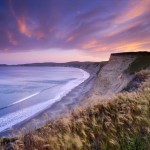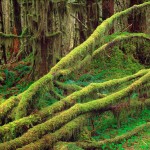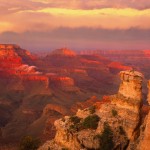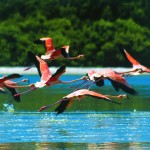Workshops by Focus: Sense of Place
Point Reyes National Seashore and the Marin Coast are truly a photographer’s playground, rich with diverse subject matter – landscape, seascape, flora and fauna – with ever-changing light and the beautiful interplay of sun and marine fog. It’s the perfect setting for a workshop focused on developing creativity and honing skills. The talented team of Jerry Dodrill and Justin Black will teach you to take control of the finer points of composition, exposure and tonal control, and specialized techniques for approaching this sublime coastal landscape.
Scheduled during the spring wildflowers season and during mid-week to avoid weekend crowds, we will spend our morning and evening field time at locations along the Marin County coast as far north as Tomales Point and as far south as Marin Headlands. Old-growth redwood forest, the blooming flanks of Mt. Tamalpais overlooking the Pacific, seastacks and cliffs, wild beaches, headlands, tule elk, seals, sea birds, and more make this place very special indeed.
My good friend and colleague, Jerry Dodrill, and I started our photographic exploration of this astonishing landscape when we worked with the late Galen Rowell, leading workshop groups to the Marin coast from Galen’s gallery in Emeryville. Jerry has chosen to spend the last eleven years here, chasing storms and photographing along edges of land and sea, earth and sky, fog and light. As Galen pointed out in his book Bay Area Wild, this piece of coastline is a spectacular natural treasure, despite being within easy day-trip range of a major metropolitan area. Those who live nearby just might begin to take its wonders for granted, but it is amazing what you can find here when you approach it with eyes wide open. –Justin Black
This four-day, four night Creative Core workshop deals heavily with composition, working with changing light, exposure control, essential gear and creative tools, fundamentals of digital workflow, and introduction to digital exposure blending and stitching, and an intense schedule of photography in the field followed by constructive group critiques. Creative Core workshops are generalist outdoor photography workshops and the emphasis of any individual participant’s work is up to them, whether they wish to focus on landscape, macro, wildlife (as the opportunity presents itself), abstraction, color, black and white, HDR, panoramics, multiple exposures, or all of the above. Any enthusiastic photographer will feel right at home in this workshop. In our experience, most participants will be solid intermediates with a couple relative beginners and a handful of advanced photographers. Jerry and Justin each have over a decade of experience successfully accommodating a range of experience levels at workshops.
Very often, we are amazed by the way in which the beginners teach the advanced students a thing or two about unrestrained creative openness and serendipity, while the expertise of the advanced students can be a welcome resource for the rest of the class. We supply materials in advance of the session to get newcomers up to speed with basics having to do with digital camera set-up and techniques, essential equipment recommendations, and other guidelines to ensure that everyone is ready to make the most of the experience.
Lodging, all meals, and beverages are included in the package.
The Olympic Peninsula offers an astonishing array of landscapes and micro-climates in a relatively compact area. From its dramatic rocky coast and tidal pools, to old-growth temperate rainforest, to alpine meadows, glaciated peaks, and vast wilderness, it seems to have it all. Marine fog pours through mountain passes, filling inland valleys while ridge-top meadows in full bloom bask in the sun. Roosevelt elk bugle in the lush forest, home to some of the world’s largest trees. The snowcapped splendor of the Olympic Mountains provides a constant backdrop. No one knows this majestic place better than the award-winning photographic team of Terry Donnelly and Mary Liz Austin.
Click the “read more…” tab below right to continue and see the photo gallery.
What happens when a group of enthusiastic photographers join together for a 10-day raft trip through 226-miles of mind-bending Grand Canyon scenery and 1.75 billion years of geological history?
Here are some impressions that our friends from past trips have shared with one another:
The sand may be gone, but my mind is still in the Canyon. Thanks to you, Jack and Justin, for putting together this amazing experience. The Canyon is past wonder. I am sitting here working on the images and can’t seem to leave the river.
While I think I’ve finally gotten the sand out of all of my clothes, equipment and person, it will most definitely be a long time before I get the Grand Canyon sand out of my soul. I think Jack said it best when he said that the Grand Canyon was a special temple. It is awe-inspiring. I really enjoyed my time with you all, and hope to see all of you again on another Jack and Justin adventure.
About two days into the trip…I realized that I should enjoy the trip because it was just about as good as it gets. It was indeed. At this point, maybe it’s enough to say that I actually miss the sand and I hope we all will continue to keep in touch.
Designed by Jack Dykinga and Justin Black, this trip absolutely maximizes photographic potential and overall quality of experience that can be had during ten days on the Colorado River in the mile-deep Grand Canyon.
* Note: Please click the “read more” tab below right for all the details, the image gallery, and National Park Service concessionaire compliance information.
Applying our experience of numerous Grand Canyon raft trips, and in collaboration with our hand-picked crews from Arizona Raft Adventures (AZRA), we’ve developed an itinerary that takes advantage of favorable spring conditions and sets us up for the best landings for photo excursions and camps along the river. This detailed planning and the expert skill of experienced boat crews we’ve worked with before are critical, because there’s no going back upstream on the Colorado River.
This trip is scheduled for May, when water and wildflowers are in greater abundance, and daytime temperatures are a bit cooler than the rest of the river guiding season. Our itinerary starts in Flagstaff, Arizona, at the Radisson Woodlands hotel. The afternoon before our departure for the river, we will convene to get to know each other (and catch up with returning friends), and Jack will make an introductory presentation to get your creative juices flowing. This will be followed by an orientation by AZRA staff to go over the game plan, safety, answer questions, and distribute dry bags for packing your personal gear. We’ll set off early the following morning for Lee’s Ferry, where our raft and crew will be waiting for us at our launch point.
A little about the raft: We will use a 32-foot-long raft built around a strong aluminum frame with a below-deck cargo hold for important items that tolerate getting wet, like camp chairs and cans of beer. Personal gear and camera bags will be stored in drybags strapped to lockers on deck above the waterline. Two expert AZRA guides will crew our raft, which is equipped with a small, quiet four-stroke Honda motor for steering purposes. The motor is shut off as we drift with the current down the river in stretches of calm water. We will be running a great deal of whitewater, and where you sit in the raft will determine whether you get soaked or stay dry (or dryish). Getting soaked by a big splash is a great way to cool off, as is floating a rapid in your life vest, which the guides offer as an option on occasion and as safety conditions permit.
Once on the Colorado River, we quickly enter Marble Canyon and from there the canyon rim towers higher and higher as we pass through ever more ancient rock strata. From the raft, we’ll take in the stunning mesas and rock formations all around us, watch bighorn sheep just a few meters away at the water’s edge, marvel at condors soaring overhead, and watch the light and shade play across the water and reflect in hues of gold and red on the canyon walls. Each afternoon, we’ll pull into riverside beaches, which will serve as our camps. These are selected in advance for group comfort and excellent photo opportunities close to camp in the evening, and to position us strategically to target the next morning’s photography location.
As we arrive in camp each afternoon, we’ll form a “bag line” as a team to unload personal gear and camp equipment from the raft to the beach. This group bonding experience is not to be underestimated. After that, we each locate our personal piece of Colorado River beach to put down our tarp, sleeping pad, pillow, sheet, and sleeping bag (all provided, as are tents, though no one seems to bother with them after a night or two). Then, while the boat crew prepares a fabulous and well-deserved dinner, Jack and Justin will lead photo sessions in the evening light. Otherwise, choices of camp activities are up to you. We’ll gather the camp chairs in a circle to chat over a beer or glass of wine, have a rinse in the river as conditions permit, or just relax and enjoy the peace, solitude, and crystal clear night skies.
When our time on the river comes to an end, it will be too soon. We will have been away from computers, cell phones, and traffic for ten days. AZRA will pick us up at Diamond Creek for the trip back to the Radisson in Flagstaff, stopping off on old Route 66 at Delgadillos Snow Cap in Seligman for an obligatory milkshake (or two). After a proper shower and calls to loved ones to confirm that we’ve reemerged into civilization, we’ll meet for a final group dinner with our boat crew. After breakfast the next morning, we’ll meet to edit and project images for review and critique. Wrapping up by mid-afternoon, we’ll say “until we meet again,” and our merry band will part company with hard drives full of amazing images, heads full of incredible memories, spirits uplifted by the experience, and hearts just a little heavy that it’s all over.
We hope you’ll join us for this trip of a lifetime, especially if it’s for the second time!
* NOTE: The raft-trip component of this package is operated through Arizona Raft Adventures, a National Park concessionaire. National Park Service rules require that we disclose and distinguish our cost for the AZRA ten-day raft trip itself, which is $2840 per participant. The fee for the photographic workshop, the days prior to and following the AZRA raft trip, is $3,155. This includes instruction, critique, meals (beginning with dinner the night before the raft trip and ending with lunch the day after the raft trip), lodging in Flagstaff the night before and the night after the trip, as well as all taxes and gratuities. The total combined cost for the raft trip and workshop is $5,995 per person.
In the final year of the 5,126-year Mayan calendar cycle, we bring you a very special expedition for six photographers into this land of hidden cenotes, stunning pre-Columbian cities, elegant haciendas, and abundant tropical life.
The Mexican state of Yucatán, on the west side of the peninsula, is a world apart from the more familiar tourist Mecca of Cancún. It is a wonderful, safe, and intriguing place, rich with human and geological history and overflowing with haunting beauty. Subtropical forest conceals beneath its roots a geological sponge of porous limestone. The Chicxulub impact crater, created by the asteroid that ended the age of the dinosaurs 65 million years ago, filled with water that dissolved pockets and channels in the subterranean limestone around its periphery, creating myriad caves and underground rivers.
Whenever these caves and sinkholes open to the outside world, they are known as cenotes (seh-NÓH-tehs). The inspiration for countless Mayan legends, these crystal clear underground pools and grottoes will be a primary focus of this expedition, which will also feature pre-Columbian Mayan sites, elegant and updated 19th-century haciendas full of historic character, and the largest pink flamingo colony in the world at Celestún Biosphere Reserve.
Of the thousands of cenotes distributed across the Yucatán, some have wide-mouthed cave entrances, inviting the visitor to walk in to discover the fantastic subterranean grottoes they conceal. In the darkest cenotes, we’ll creatively illuminate the walls, stalagmites and stalactites, and other formations both above and below water, using lamps and strobes that we bring along. Others admit brilliant shafts of natural light that spotlight the blue water and reflect to illuminate the interior. Some cenotes are open-air sinkholes holding inviting pools of cool, clear water. Most are undeveloped and virtually impossible to find without the benefit of a knowledgeable local guide.
We have arranged for our friend Alfredo Medina to lead the way. Since 1992, Alfredo has lived in Quintana Roo on the peninsula’s east coast, where he owns a high-end printing business. He carried out extensive photographic coverage of Yucatecan cenotes for his beautiful book Cenotes: Imprints of Water and Light in the Jungle, published in 2008. Alfredo is also co-photographer for the book Birds of the Yucatán Peninsula (1997). Alfredo and his wife, Sara, serve as trustees for the non-profit conservation organization Amigos de Sian Ka’an, promoting conservation action on the Yucatan peninsula.
Jack Dykinga and Justin Black collaborated with Alfredo in October 2009, during a Rapid Assessment Visual Expedition (RAVE) in the Yucatan operated by the International League of Conservation Photographers, while Justin was the ILCP’s Executive Director. Guidance by Alfredo and his wife Sara was critical to our RAVE assignment, accessing beautiful cenotes off the tourist routes, known only to the friendly and gracious Mayan locals. Alfredo is a true gentleman explorer, a gifted photographer, and an absolute pleasure to work with.
In addition to several cenote excursions, our group will visit the pre-Columbian Mayan City of Uxmal, spectacularly situated in the Puuc hills south of Merida. Considered by many to be the most architecturally beautiful Mayan city, Uxmal was built between 600 and 900 A.D. Due to excellent construction, it is one of the few Mayan cities to remain sufficiently well-preserved to provide the modern visitor with a good sense of what the central ceremonial district would have been like at its peak. The pyramids, temples, hieroglyphs, mosaics, and sculptures here are sublime and full of mystery.
Another Mayan pyramid rises immediately behind the main house at Hacienda Itzincab-Cámara, our lodging for the first four nights of the expedition. “Itzincab,” as it is known locally, is a photographer’s dream in itself, with recently restored 19th-century architecture, lush tropical gardens, and excellent bird habitat. We were welcomed as guests at Itzincab during the ILCP RAVE and were singularly impressed by the hospitality of the staff, the comfort and elegance of the accommodations, and its exceptional suitability to serve as a workshop base. Read more about this special place below under “Accommodations.”
For our final two nights, we will relocate to Eco Paraiso near the estuary of Celestún Biosphere Reserve, where 30,000 pink flamingos gather in January each year to form the largest colony of the species to be found anywhere on Earth. Celestún is also host to over 300 other species of birds and many species of reptiles, including Morelet’s and American crocodiles, four sea turtle species, iguanas, land turtles, and boa constrictors.






